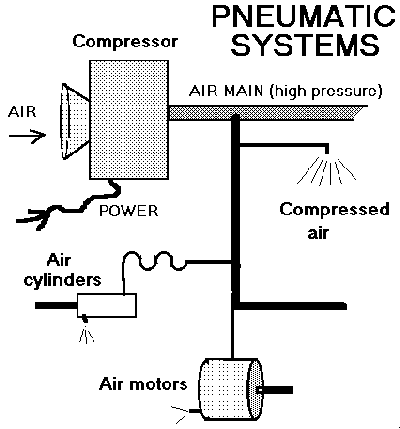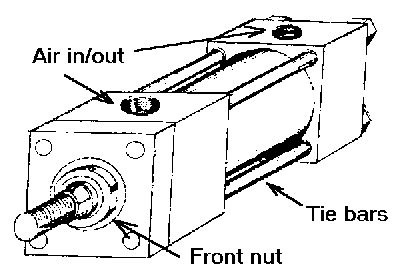5. PNEUMATICS5.1 Pneumatic systemsPneumatic systems use pressurised air to make things move (for example, pistons), to hold things up (for example, car tyres), or to move things (for example, air lines inside hopper feeder tubes). (figure 10)
 Dealing with pneumatic systems poses some dangers: if you puncture the balloon tyres on an earth mover they may rip open and injure you. If you puncture a high pressure air line, small particles of flying dust or metal may damage your eyes. Pneumatic systems are used mainly in the following situations: Again taking our earlier analysis, in pneumatic systems there are sources of energy, methods for transporting that energy, and then methods for expending that energy. Compressors take atmospheric air and squash it - creating air at high pressure. Strong pipes then carry this high pressure air to where it is needed. This air can then be used in a number of ways. 5.2 CompressorsA compressor is basically a large pump, operating at high speed. It takes air of volume X, and reduces this volume by factor Y, so increasing the pressure proportionately. This process expends a lot of energy, and also creates a lot of heat (you may have found when pumping up a bike tyre that the end of the pump gets hot). In fixed locations compressors are normally electrically powered. On mobile equipment they are engine driven. This provides 'two bites of the cherry' in terms of sabotage. You either take on the energy source - be it the engine or the electric motor, or you take on the compressor itself. The first obvious flaw in the compressors design is the air intake - this is normally covered with some form of fabric filter or gauze. By removing this cover you can pour fine power or small abrasive particles into the air intake. On smaller compressors, pouring resin/glue into the intake will have a similarly damaging effect. But beware, the effect, especially on a large compressor, may be rapid and severe. If possible rig up some system to remotely pour in the material, or throw it in from a safe distance. Next, there are the control systems of the compressor itself. Compressors working from engines are normally very simple affairs, but large industrial compressors are very complicated machines, with complex control mechanisms. If time is short, damaging the control mechanisms is the easiest option. This is best done with the compressor not working - most large compressors are fitted with 'emergency stop' buttons, and simply hitting this will shut down the system. You then can work on the control boards, BUT BEWARE, stopping the compressor does not isolate power from the electrical systems! Another important part of large compressors is lubrication - in some situations this may also act as a coolant. Where there is no other option, draining the lubricant or coolant will normally cause the shutdown of the compressor - either because it seizes up or because the control systems detect the change and cause automatic shutdown. Finally, you may be tempted to damage the main airline leaving the compressor. If the compressor is operation this could be lethal. If you do this with the compressor off, it may injure someone when the system starts. The pressures involved make it too risky. The safer option is to take the air lines further down the system on the smaller bore pipes (the smaller the pipe... the less the capacity for air flow... the safer it is to cut). One last thing - do not get a compressor confused with a chiller. They can look similar, but the main way to tell them apart is that the main movement of air is into a compressor, but out of a chiller. Also, the air leaving a chiller is warm, and there is normally a lot of water swilling around. 5.3 Air linesAir lines are very simple things. They are pipes that carry air under pressure from the compressor to where it is needed. But air lines are very dangerous. If you cut a long flexible (plastic or rubber) tube, it will begin whipping around, and could injure anyone stood nearby. Likewise, any metal air line with a diameter of more than 10mm could contain a lot of energy - cutting it might cause shrapnel to hit you, and the hiss of air from the split will act like a steam whistle, which could damage your hearing. In general, if an air line is made of steel, it is because it is meant to carry a lot of pressure - so you might consider not cutting it. Flexible or plastic lines carry lower pressures, and are easier to cut. A safe way to damage larger air lines, in a way which is difficult to find, is to hand drill then with a small - 1 or 2 mm - drill. If you do this in enough places, the air leakage will not be dangerous, but the leakage will be significant enough to affect the system. 5.4 Cylinders and motorsOne of the main uses for compressed air in industry is to make things move - from printing machines to advanced robotic assembly systems. The main component in these systems is the pneumatic cylinder. Cylinders work 'in reverse' to an average bike pump. Air is inject at one end or the other. This moves the piston inside the cylinder, and the rod connected to it. The power with which this takes place is proportional to the diameter of the piston - the greater the more power. Unlike hydraulic systems, where fluid is conserved, in pneumatic systems the compress air is always released. Whereas a hydraulic ram needs to be pushed in both directions, the pressure in the 'live' side of the cylinder pushes against atmospheric pressure (which is much lower), and the piston moves. To make the piston go back and forth it is therefore necessary to have two-way valves which allow the air to flow out of the cylinder, but switch to allow high pressure air in when the piston needs to go back. A simple way to disable the cylinder is to damage or remove this valve. In cylinders where fast movement is needed the valve will be located on the cylinder, but otherwise you will have to trace the pipes back to where the valve is located. Sometimes the two-way valve is incorporated into the mechanical or electromechanical switch which controls the cylinder - in which case you can do even more damage. There is a very simple way to disable cylinders - cut the pipes leading to them. This of course is easily fixed. If you have more time there are three other options: Typical pneumatic cylinder (fig. 11)

Air motors look similar to small electric motors - except they run on compressed air. They are very well built, and so are difficult to damage. The simplest way to deal with them is to inject mastic or resin into the air input. If you really want to make a mess, inject as much glue as possible, then reconnect the air line and turn it on for a few seconds. 5.5 Tyres and balloonsAnother example of systems are inflated vehicle tyres. These fall into two types: The most straightforward way to damage balloons is to use a small drill and drill through the wall (but beware because the vehicle will tip as the tyre deflates). There are two options with normal tyres. You can drill through the tyres, but it is often simpler and quicker to cut off the valve of the inner tube with side cutters - but put a rag or something soft over the top of the valve before you cut in case it flies off as the air comes out. 5.6 Basic sabotage of pneumatic systemsHow you tackle pneumatic systems will depend upon the accessibility of the parts of the system, and how much time you have. If you have access to the compressor, the simplest option would be to stop the system using any emergency shutdown systems, and then disable the compressor. The only thing to beware of is that on electrical powered systems the power will still be live - although this can be solved by finding the junction box/isolator for the compressor and switching it off. If the compressor is not accessible, then you have two options: Where no part of the system is accessible except the air intake - this is normally in factories - then you will have to load oil, or some form of powder, into the air intake. This will just clog the filter - so if you can puncture any accessible filters that will help enormously. The quickest method to disable to entire system will be to take the power source away - either disable the engine driving the compressor (this is the setup of mobile systems) or isolate the electrical supply and burn the cables/control systems (this works on fixed systems).
[Back to Contents]
[Go to next section]mailto:webmistress@sabotage.org goto:webmistress |